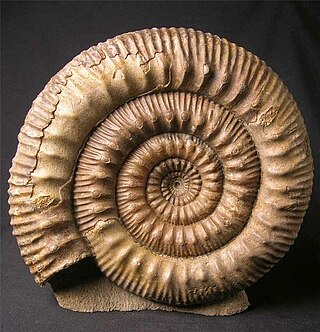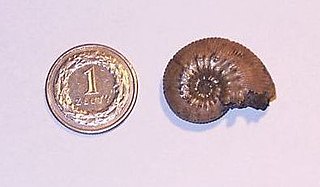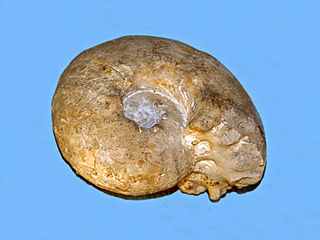
Stephanoceras is an extinct genus of Stephanoceratoid ammonite which lived during the Bajocian. It is the type genus of the family Stephanoceratidae.

Aspidoceras is an extinct ammonoid cephalopod genus belonging to the family Aspidoceratidae.

Audaxlytoceras is an extinct genus of lytoceratid ammonites.
Berniceras is an extinct ammonite genus from the order Ammonitida that lived during the early Oxfordian stage of the Late Jurassic. Berniceras is included in the ammonite family, Oppeliidae.

Kosmoceras is a moderately evolute ammonite genus from the upper Callovian of Europe with a simple apterure and irregular ribbing interrupted by an irregular row of lateral tubercles. Strong ventral tubercles are separated by a smooth depression running along the rim.
Fontannesia is an ammonoid cephalopod genus with a small to medium size, evolute, discoidal shell that was extant during the Jurassic Period. The sides are ribbed, the venter has a single median keel, and tubercles are lacking.
Euaptetoceras is an evolute hildoceratoid ammonite from the lower Middle Jurassic, included in the family Hammatoceratidae and the subfamility Hammatoceratinae. The genus may be a junior synonym for Eudmetoceras of Buckman, 1920.
Ermoceras is a genus of ammonite belonging to the Thomboceratidae family of the Middle Jurassic found in deposites of central Arabia, Sinai, and Algeria with strong primary and secondary ribs and a single row of lateral tubercles; described as having a deep ventral groove

Durotrigensia is a genus of ammonites (Ammonitida) in the perisphinctoid family Parkinsoniidae.
Phaulostephanus is an extinct genus from the ammonoid family Stephanoceratidae, which is part of the ammonitid superfamily Stephanoceratoidea, that lived during the early Middle Jurassic.
Otoites is the type genus of the ammonite family Otoitidae that live during the Middle Jurassic.

Normannites is a strongly ribbed evolute Middle Jurassic genus of ammonite included in the stephanoceratoid family Stephanoceratidae.

Peltoceras is an extinct ammonite genus from the aspidoceratid subfamily Peltoceratinae that lived during the later part of the Middle Jurassic.
Eoderoceras is an evolute, round whorled ammonite from the Lower Jurassic with an outer row of distinct spines, and in some, an inner row of tubercles, on either side; ribs only on the inner whorls.
Microderoceras is a flat sided, evolute, radially ribbed Lower Jurassic ammonite belonging to the ammonitid family Eoderoceratidae and superfamily Eoderoceratoidea. Its whorls are subquadrangular in section; venter on the outer rim, rounded; sides with two rows if distinct spines, tubercles on internal molds, formed at either end of the ribs. The lateral surface of the ribcage is concave toward both sides, the lateral side of the dorsal and the lateral side of the ventral surface. The ribs are divided into six pairs (1-3) of the following types: 2-3 is the only type. In the first type, the ribs on the ventral face are fused to the ribs on the ventral sides; the ribs on the dorsal face are fused to the ribs on the dorsal sides. The second type represents the ribbed body, the ribs are in the same arrangement as in the first type and the rib cage does not fuse to the dorsal surface.
Distichoceras is a member of the Haploceratacean family, Oppeliidae, and type genus for the subfamily Distichoceratinae, found in upper Middle and lower Upper Jurassic sediments in Europe, Algeria, India, and Madagascar. The shell is essentially evolute and compressed with the outer flanks converging on a narrow, keeled venter; inner flanks which may be feebly ribbed, are separated from outer by a shallow spiral groove or band. Ribs on outer flanks end on or are looped to tall clavi that line the venter, standing above the keel.
Ptycholytoceras is a genus of fast-moving nektonic ammonoid carnivores included in the Lytoceratinae in which the shell has round inner and depressed outer whorls and sides with dorso-ventrally sloping folds that do not pass onto the venter.
Dayiceras is a finely ribbed polymorphitid eoderoceratacean ammonoid cephalopod from the Jurassic, named by Spath in 1920. The shell is evolute, coiled such that all whorls are exposed. The whorl section is compressed such as to be higher than wide. A row of fine tubercles runs along the middle of the outer rim, the venter.

Orthaspidoceras is an extinct ammonoid cephalopod genus belonging to the family Aspidoceratidae. These nektonic carnivores lived during the Jurassic period, Kimmeridgian age.

Virgatites is an extinct genus of ammonoid cephalopod belonging to the family Perisphinctidae. Related genera in the Virgatitinae include Acuticostites and Zaraiskites. Species in this genus were fast-moving nektonic carnivores.








